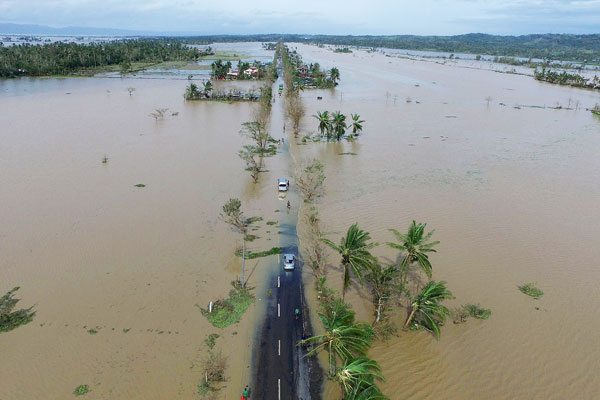LEGAZPI CITY: At least seven people were dead and many others injured amid massive damage to private and government property as well as agricultural crops, as Typhoon “Nina” forced the provinces of Albay and Camarines Sur to declare a state of calamity.
Nina made landfall on the eastern island province of Catanduanes with gusts of 235 kilometers an hour on Christmas Day, ravaging the Bicol region and surrounding areas before moving west across the country.
Governor Joseph Cua of Catanduanes, the first province to be hit by the typhoon, said there was one reported death and numerous injuries in his province.
In Albay province, three people were reported dead. Espelita Begas Marilad, 57, of Zone 6, Balangibang, Polangui town was hit by a concrete wall that fell in her residence.
Couple Antonio Calingacion, 73, and Teresita Calingacion, 70, of Balinad village, Polangui town were found dead at Viga River.
Another person was killed and two more were injured when the storm toppled a power line in Quezon province, electrocuting them, a police report said.
Two people also died after suffering heart attacks during the storm but it was unclear if those deaths were directly related to the typhoon, local government reports said.
Undersecretary Ricardo Jalad, executive director of the National Disaster Risk Reduction and Management Council, said a total of 77,560 families or 383,097 persons from Calabarzon (Cavite, Laguna, Batangas, Rizal and Quezon), Mimaropa (Mindoro, Marinduque, Romblon and Palawan), Bicol and Central Visayas were preemptively evacuated to safer grounds.
Of this figure, a total of 17,277 families or 72,869 persons were displaced in at least 202 barangays (villages) in Mimaropa and Bicol regions.
Eighty-three areas in Mimaropa and Bicol have been experiencing power interruptions since Christmas. Seven power lines in these areas and in Calabarzon were cut off.
The Armed Forces of the Philippines reported that in Quezon province and Bicol region, eight patrol bases were severely damaged while 12 others were partially damaged.
‘Sleepless Christmas’
Torrential rains flooded Albay, while numerous houses made of light materials were flattened to the ground in Catanduanes. The two provinces declared a state of calamity to allow the release of disaster funds.
“Coconut plantations were totally damaged and numerous families were left homeless on Christmas Day,” said Bernardo Rafaelito Alejandro, regional disaster council director.
Governor Cua said Catanduanes remained powerless as numerous electric posts fell to the ground. Communication lines also went down, he said.
At Cua’s request, four C-130 planes brought relief goods for typhoon victims in the island.
The provinces of Albay, Batangas, Camarines Sur, Quezon and Sorsogon suffered power outages, while roads from Bicol, especially in the municipality of Nabua, Camarines Sur, going to Metro Manila were impassable to all vehicles because of landslides, floods and debris.
Nelson Bautista, National Grid Corp. of the Philippines spokesman, said transmission lines and facilities affected by the typhoon Nina were: the Naga-Lagonoy 69 kV line covering Casureco II & IV utilities; Naga-Tinambac 69 kV line; Naga-Concepcion 69 kV line; Naga-Iriga 69 kV line; Daraga-Ligao 69 kV line; the Daraga substation; Tiwi-Pawa-Tabaco 69 kV line, and the power lines in Soreco I and Soreco II in Sorsogon province.
In the Bicol town of Ligao, many streets and surrounding farms were covered by ankle-deep water while some homes remained caked in mud left by flooding.
Masseuse Erna Angela Pintor, 20, said she and her family spent a sleepless Christmas in fear as the strong winds ripped off part of their roof.
Neighbors living near a river sought refuge in their home as the waters rose to their chests, she said, though her own family was luckier.
“The floods [last night] only reached to our knees. Thank goodness the current wasn’t that strong,” she told AFP.
“This was supposed to be a celebration but we cannot celebrate. This is a sad Christmas for us. No one [in the family] died but a lot of our neighbors’ homes were washed away.”
Manila spared
By late Monday afternoon the typhoon had weakened, with wind gusts of 180 kilometers per hour, and was in the West Philippine Sea heading west away from the country, government weather forecaster Gener Quitlong said.
The typhoon had been expected to bring heavy rains and winds to Manila, but the city of 13 million residents was spared after the typhoon lost force as it crossed the eastern islands.
“It was like a blessing in disguise. Every time it hit land, its diameter lessened. It also lost moisture so it became weaker,” Quitlong told AFP.
Lubang Island and the western portion of Batangas remained under Tropical Cyclone Warning Signal No. 2, while southern Zambales, Bataan, the rest of Batangas, Cavite and the northern portions of Occidental and Oriental Mindoro were under Signal No. 1.
By Wednesday afternoon, Typhoon “Nina” is expected to be at 230 kilometers northwest of Pagasa Island in Palawan, outside the Philippine area of responsibility.



